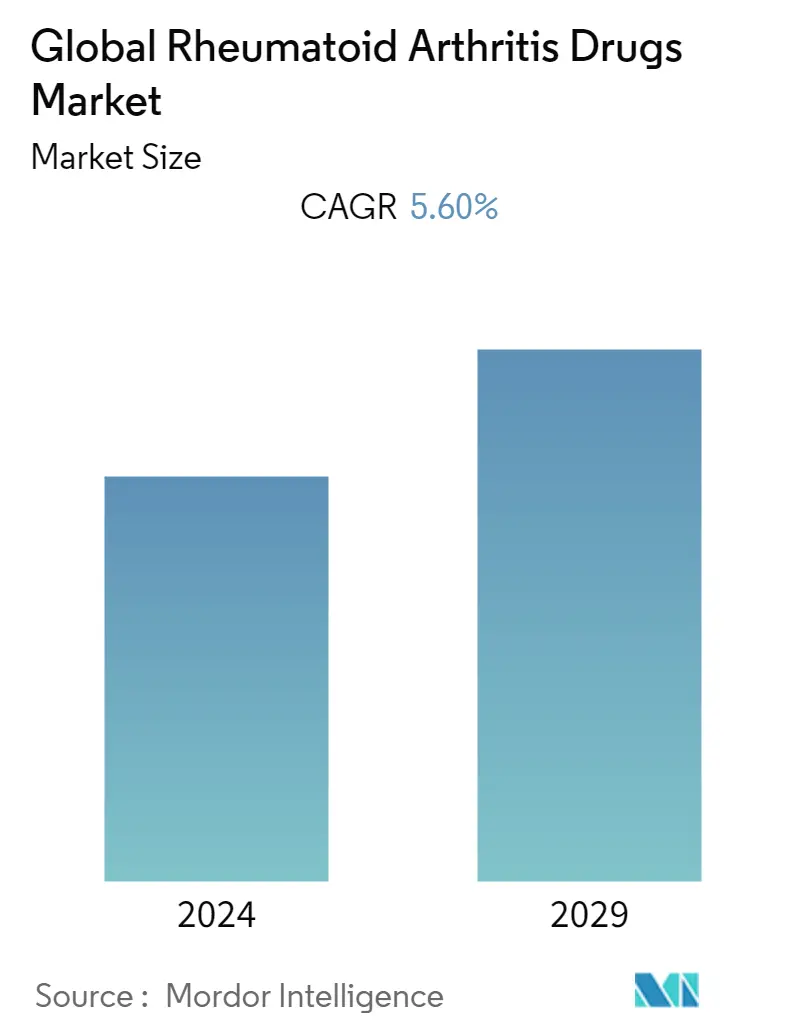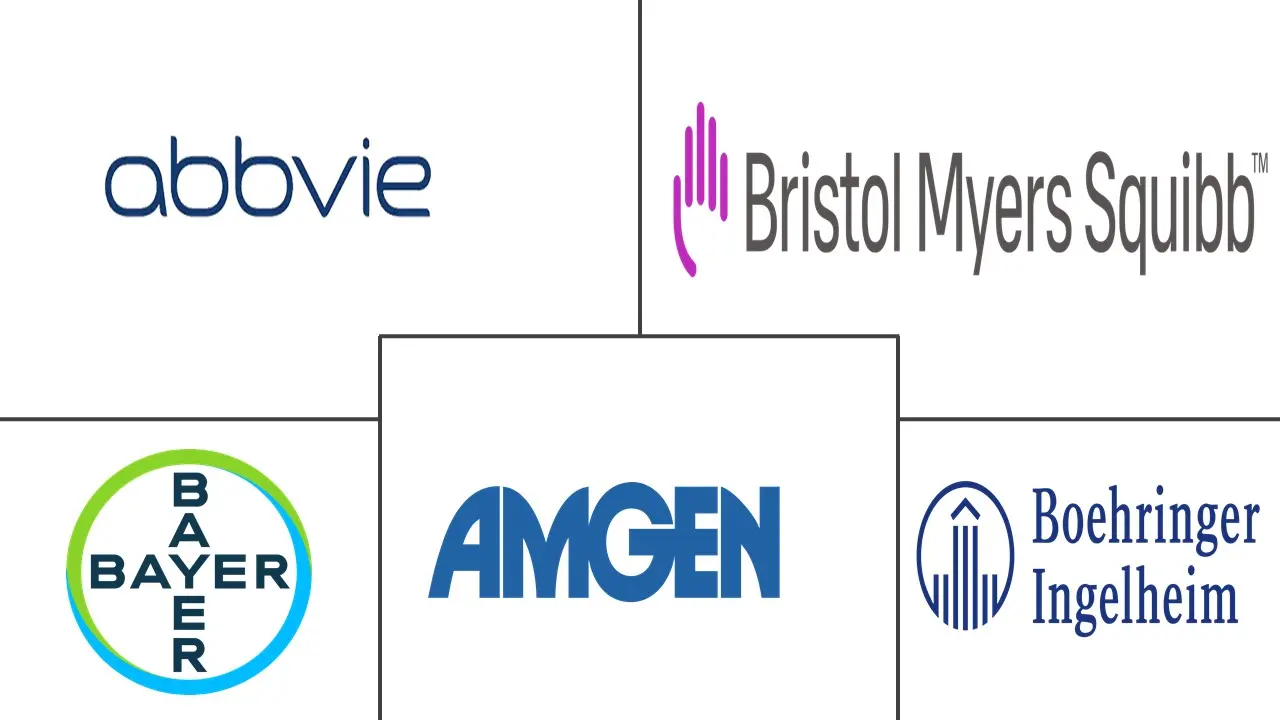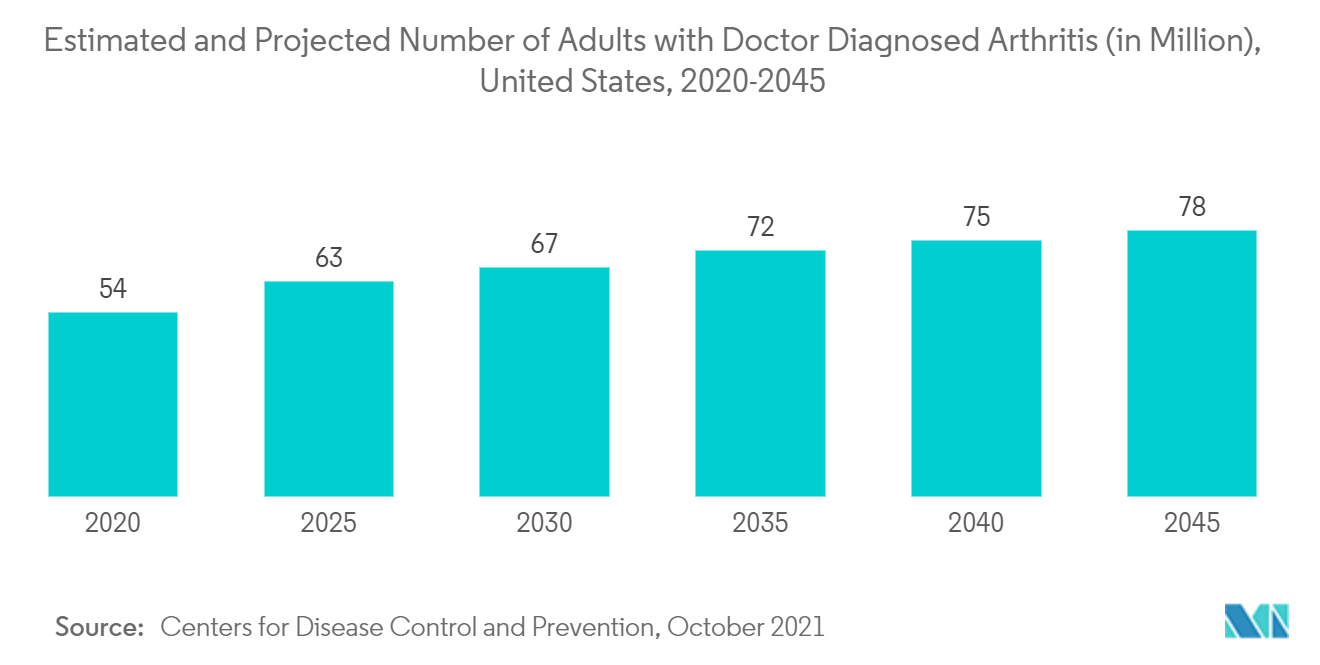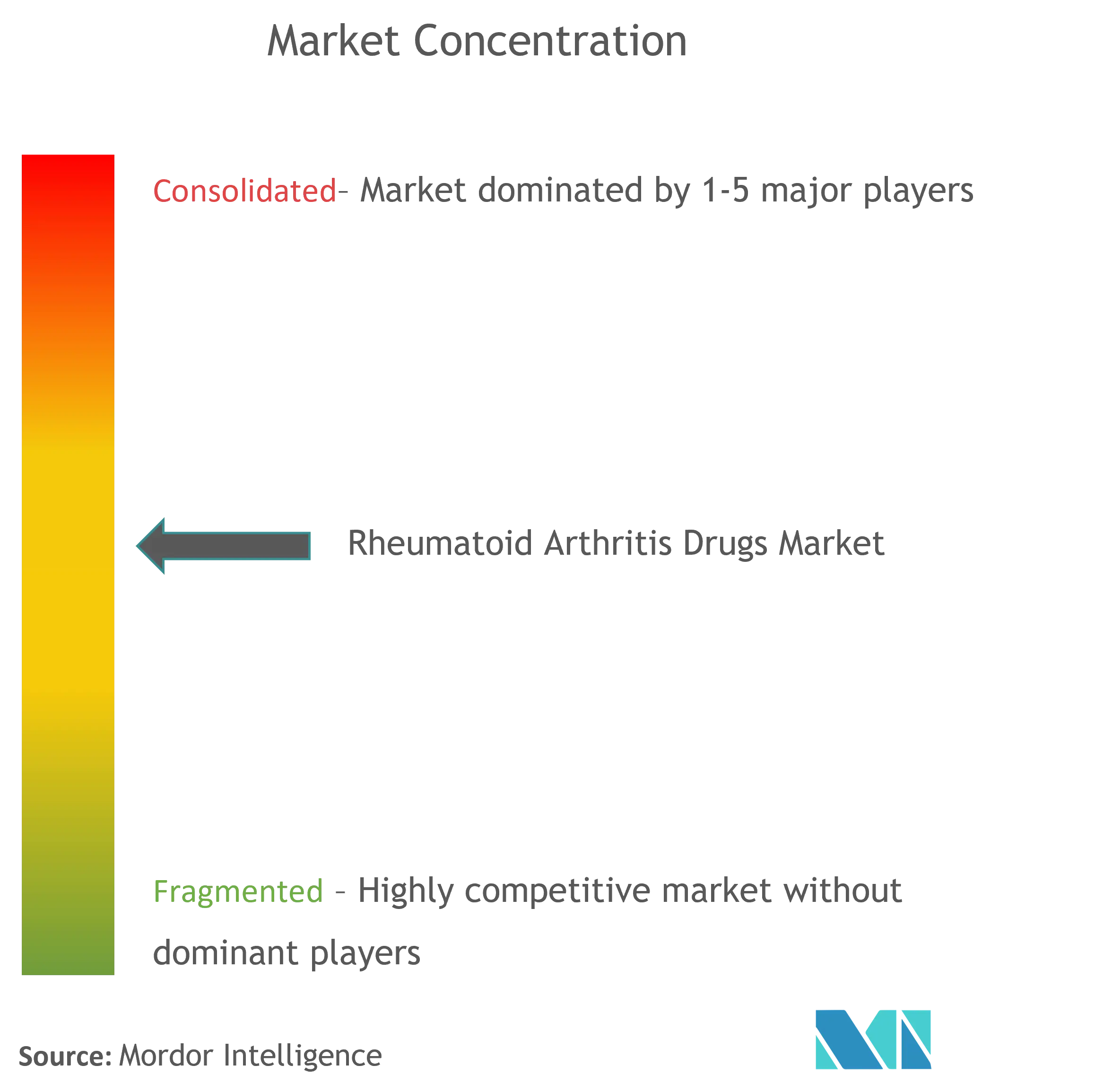Rheumatoid Arthritis Drugs Market Size

| Study Period | 2019 - 2029 |
| Base Year For Estimation | 2023 |
| Forecast Data Period | 2024 - 2029 |
| CAGR | 5.60 % |
| Fastest Growing Market | Asia Pacific |
| Largest Market | North America |
Major Players
*Disclaimer: Major Players sorted in no particular order |
Rheumatoid Arthritis Drugs Market Analysis
The rheumatoid arthritis drugs market is poised to grow at a CAGR of 5.6% during the forecast period (2022-2027).
COVID-19 had a significant impact on the rheumatoid arthritis drugs market as rheumatoid arthritis (RA) patients had a higher risk of COVID-19 infection. For instance, according to the study titled "Risk of COVID-19 in Rheumatoid Arthritis: A National Veterans Affairs Matched Cohort Study in At-Risk Individuals" published in October 2021, patients with rheumatoid arthritis (RA) were more likely to develop COVID-19 and severe COVID-19 (which can lead to hospitalization or death) than those without RA. In addition, the study titled "The COVID-19 pandemic: an increased risk of rheumatoid arthritis" published in June 2021, reported that because of the iatrogenic consequences of RA-related pharmacological therapy, patients predisposed to RA have a greater infection risk than the general population. As a result, a COVID-19 pandemic might increase the probability of a health emergency in complicated conditions such as RA. Thus, owing to such instances, COVID-19 infection had a pronounced impact on the rheumatoid arthritis drugs market over the forecast period.
The key factors propelling the growth of the rheumatoid arthritis drugs market are the launch of new biosimilars, the rising prevalence of arthritis worldwide, and an increase in the acceptance of biopharmaceuticals.
According to the study published in Rheumatology International, titled "The global prevalence of rheumatoid arthritis (RA): a meta-analysis based on a systematic review" in November 2020, the global prevalence of RA was estimated to be 0.46 percent. This will lead to increased adoption of therapies for RA treatment and thus drive the market's growth.
Additionally, rising product launches by the market players are expected to boost the market's growth. For instance, in September 2020, Lupin launched generic leflunomide in the United States to treat adults with active rheumatoid arthritis. This will lead to increased adoption of rheumatoid therapies in patients, driving the market growth. Moreover, rising approvals of biosimilars for treating rheumatoid arthritis also contribute to market growth. For instance, in October 2021, the United States Food and Drug Administration approved Cyltezo. It is one of the first interchangeable biosimilars to Humira to treat rheumatoid arthritis.
Thus, owing to the abovementioned factors, the market is expected to show growth over the forecast period. However, alternative treatment options and patent expiration of branded drugs may hinder the market's growth during the forecast period.
Rheumatoid Arthritis Drugs Market Trends
This section covers the major market trends shaping the Rheumatoid Arthritis Drugs Market according to our research experts:
NSAIDs Segment is Expected to Hold a Major Share Over the Forecast Period
The NSAIDs segment is expected to hold a significant share of rheumatoid arthritis drugs during the forecast period. NSAIDs are being widely utilized for the symptomatic treatment of rheumatic disorders. Disease-modifying anti-rheumatic drugs (DMARDs) are also considered the gold standard for treating moderate to severe rheumatoid arthritis. However, DMARDs are used to prevent rheumatoid arthritis from becoming worse, NSAIDs (non-steroidal anti-inflammatory medicines), in contrast, are used to treat disease conditions like inflammation for offering symptomatic relief in patients.
The increasing prevalence of the disease globally is boosting segment growth. With the growing number of arthritis cases, the use of NSAIDs and their production is expected to observe healthy demand and supply throughout the forecast period.
According to the study published in Frontiers in Immunology, titled "Promising Therapeutic Targets for Treatment of Rheumatoid Arthritis" in July 2021, nonsteroidal anti-inflammatory drugs (NSAIDs), including acetylsalicylate, naproxen, ibuprofen, and etodolac, are used to alleviate pain, swelling, and inflammation and are used as the first line treatment for rheumatoid arthritis. This has led to increased adoption of NSAIDs in the treatment of RA and boosted the growth of the market segment.
In addition, the rising launch of NSAIDs for treating rheumatoid arthritis is further expected to drive the growth of the segment studied. For instance, in August 2021, Alkem Laboratories launched ibuprofen and famotidine tablets to relieve rheumatoid arthritis and osteoarthritis symptoms in the United States. Furthermore, in September 2021, Lupin launched generic Duexis (ibuprofen and famotidine) tablets used to treat the symptoms of rheumatoid arthritis and osteoarthritis in the United States market.
Thus, owing to the abovementioned factors, the NSAIDS segment is expected to show growth over the forecast period.

North America Holds a Significant Share in the Rheumatoid Arthritis Drugs Market Over the Forecast Period
North America is expected to hold a significant share in the rheumatoid arthritis drugs market and show the same trend over the forecast period. Factors such as the rising prevalence of disease, the strong foothold of key market players, rising launch of novel therapies such as monoclonal antibodies for rheumatoid arthritis, rising investments from the market players in the research for the development of novel treatments and biosimilars for this disease are expected to drive the market growth of the studied market in the region.
According to the Centers for Disease Control and Prevention (CDC), in October 2021, about 1 in 4 United States adults (23.7%) or about 58.5 million people have doctor-diagnosed arthritis. Furthermore, According to the Government of Canada, in September 2020, approximately 374,000 (1.2%) Canadians aged 16 years and older live with diagnosed rheumatoid arthritis. Such a massive prevalence of this disease creates the need for drugs for treatment and thus drives market growth.
In addition, in May 2020, Teva and Celltrion Healthcare launched TRUXIMA (rituximab-abbs) injection for rheumatoid arthritis. It is the biosimilar of Rituxan(rituximab) for this indication in the United States. Moreover, the United States Food and Drug Administration (FDA) approved Voltaren arthritis pain (diclofenac sodium topical gel, 1% (NSAID)- arthritis pain reliever) as an over-the-counter (OTC) product for the temporary relief of arthritis pain in the hand, wrist, elbow, foot, ankle or knee in adults (18 years and older). This will further lead to increased adoption of rheumatoid arthritis drugs in the United States, driving the market growth over the forecast period.
Therefore, owing to the above factors, the rheumatoid arthritis drugs market in North American region is expected to project growth over the forecast period.

Rheumatoid Arthritis Drugs Industry Overview
The rheumatoid arthritis drugs market is moderately competitive, and key players are manufacturing a majority of rheumatoid arthritis drug products. The market leaders in this industry have established their position in the market. These manufacturers have a wide product range to offer and an extensive distribution system across the world. Additionally, emerging markets in the Asia-Pacific region are witnessing the entry of small players. Some major players in this market include AbbVie Inc., Amgen Inc., Bayer AG, Boehringer Ingelheim GmbH, Bristol-Myers Squibb Company, and Eli Lilly and Company, among others.
Rheumatoid Arthritis Drugs Market Leaders
-
AbbVie Inc.
-
Amgen Inc.
-
Bayer AG
-
Boehringer Ingelheim GmbH
-
Bristol-Myers Squibb Company
*Disclaimer: Major Players sorted in no particular order

Rheumatoid Arthritis Drugs Market News
- In February 2022, the United States Food and Drug Administration (FDA) accepted for review the Prior Approval Supplement (PAS) to the Biologics License Application (BLA) for ABRILADA (adalimumab-afzb) as an interchangeable biosimilar to Humira (adalimumab).
- In February 2022, Biogen Inc and Xbrane Biopharma AB entered a commercialization and license agreement to develop, manufacture, and commercialize Xcimzane. This preclinical monoclonal antibody is a proposed biosimilar referencing CIMZIA (certolizumab pegol) to treat rheumatoid arthritis.
Rheumatoid Arthritis Drugs Market Report - Table of Contents
1. INTRODUCTION
- 1.1 Study Assumptions and Market Definition
- 1.2 Scope of the Study
2. RESEARCH METHODOLOGY
3. EXECUTIVE SUMMARY
4. MARKET DYNAMICS
- 4.1 Market Overview
-
4.2 Market Drivers
- 4.2.1 Growing Preference Towards Development of Biologics and Biosimilars
- 4.2.2 Rising Burden of Arthritis
-
4.3 Market Restraints
- 4.3.1 Patent Expiration of Blockbuster Drugs
- 4.3.2 Alternative Treatment Options
-
4.4 Porter's Five Forces Analysis
- 4.4.1 Threat of New Entrants
- 4.4.2 Bargaining Power of Buyers/Consumers
- 4.4.3 Bargaining Power of Suppliers
- 4.4.4 Threat of Substitute Products
- 4.4.5 Intensity of Competitive Rivalry
5. MARKET SEGMENTATION (Market Size by Value - USD million)
-
5.1 By Type of Molecule
- 5.1.1 Pharmaceuticals
- 5.1.2 Biopharmaceuticals
-
5.2 By Drug Class
- 5.2.1 Non-steroidal Anti-inflammatory Drugs (NSAIDs)
- 5.2.2 Corticosteroids
- 5.2.3 Analgesics
- 5.2.4 Other Drug Classes
-
5.3 By Sales Channel
- 5.3.1 Prescription
- 5.3.2 Over-the-counter (OTC)
-
5.4 Geography
- 5.4.1 North America
- 5.4.1.1 United States
- 5.4.1.2 Canada
- 5.4.1.3 Mexico
- 5.4.2 Europe
- 5.4.2.1 Germany
- 5.4.2.2 United Kingdom
- 5.4.2.3 France
- 5.4.2.4 Italy
- 5.4.2.5 Spain
- 5.4.2.6 Rest of Europe
- 5.4.3 Asia-Pacific
- 5.4.3.1 China
- 5.4.3.2 Japan
- 5.4.3.3 India
- 5.4.3.4 Australia
- 5.4.3.5 South Korea
- 5.4.3.6 Rest of Asia-Pacific
- 5.4.4 Middle-East & Africa
- 5.4.4.1 GCC
- 5.4.4.2 South Africa
- 5.4.4.3 Rest of Middle-East and Africa
- 5.4.5 South America
- 5.4.5.1 Brazil
- 5.4.5.2 Argentina
- 5.4.5.3 Rest of South America
6. COMPETITIVE LANDSCAPE
-
6.1 Company Profiles
- 6.1.1 AbbVie Inc.
- 6.1.2 Amgen Inc.
- 6.1.3 Bayer AG
- 6.1.4 Boehringer Ingelheim GmbH
- 6.1.5 Bristol-Myers Squibb Company
- 6.1.6 Celgene Corporation
- 6.1.7 F. Hoffmann-La Roche AG
- 6.1.8 Johnson & Johnson
- 6.1.9 Merck & Co. Inc.
- 6.1.10 Novartis AG
- 6.1.11 Lupin Limited
- 6.1.12 Alkem Laboratories
- 6.1.13 Regeneron Pharmaceuticals
- 6.1.14 Eli Lilly and Company
- 6.1.15 Pfizer Inc
- *List Not Exhaustive
7. MARKET OPPORTUNITIES AND FUTURE TRENDS
** Subject To AvailablityRheumatoid Arthritis Drugs Industry Segmentation
As per the scope of the report, rheumatoid arthritis is an autoimmune disorder that causes pain and inflammation in the body's joints. Rheumatoid arthritis disease primarily affects the joints of the hands, wrists, elbows, knees, and ankles. It also affects the cardiac and respiratory systems and is a systemic disease. It thus exhibits symptoms of swelling, redness, and warmth in the affected areas. The Rheumatoid Arthritis Drugs Market is segmented by Type of Molecule (Pharmaceuticals and Biopharmaceuticals), Drug Class (Non-steroidal Anti-inflammatory Drugs (NSAIDs), Corticosteroids, Analgesics, Other Drug Classes), Sales Channel (Prescription, Over-the-counter (OTC)), and Geography (North America, Europe, Asia-Pacific, Middle East, and Africa, and South America). The report also covers the estimated market sizes and trends for 17 countries across significant global regions. The report offers the value (USD million) for the above segments.
| By Type of Molecule | Pharmaceuticals | |
| Biopharmaceuticals | ||
| By Drug Class | Non-steroidal Anti-inflammatory Drugs (NSAIDs) | |
| Corticosteroids | ||
| Analgesics | ||
| Other Drug Classes | ||
| By Sales Channel | Prescription | |
| Over-the-counter (OTC) | ||
| Geography | North America | United States |
| Canada | ||
| Mexico | ||
| Geography | Europe | Germany |
| United Kingdom | ||
| France | ||
| Italy | ||
| Spain | ||
| Rest of Europe | ||
| Geography | Asia-Pacific | China |
| Japan | ||
| India | ||
| Australia | ||
| South Korea | ||
| Rest of Asia-Pacific | ||
| Geography | Middle-East & Africa | GCC |
| South Africa | ||
| Rest of Middle-East and Africa | ||
| Geography | South America | Brazil |
| Argentina | ||
| Rest of South America |
Rheumatoid Arthritis Drugs Market Research FAQs
What is the current Global Rheumatoid Arthritis Drugs Market size?
The Global Rheumatoid Arthritis Drugs Market is projected to register a CAGR of 5.60% during the forecast period (2024-2029)
Who are the key players in Global Rheumatoid Arthritis Drugs Market?
AbbVie Inc., Amgen Inc., Bayer AG, Boehringer Ingelheim GmbH and Bristol-Myers Squibb Company are the major companies operating in the Global Rheumatoid Arthritis Drugs Market.
Which is the fastest growing region in Global Rheumatoid Arthritis Drugs Market?
Asia Pacific is estimated to grow at the highest CAGR over the forecast period (2024-2029).
Which region has the biggest share in Global Rheumatoid Arthritis Drugs Market?
In 2024, the North America accounts for the largest market share in Global Rheumatoid Arthritis Drugs Market.
What years does this Global Rheumatoid Arthritis Drugs Market cover?
The report covers the Global Rheumatoid Arthritis Drugs Market historical market size for years: 2019, 2020, 2021, 2022 and 2023. The report also forecasts the Global Rheumatoid Arthritis Drugs Market size for years: 2024, 2025, 2026, 2027, 2028 and 2029.
Rheumatoid Arthritis Drugs Industry Report
Statistics for the 2024 Rheumatoid Arthritis Drugs market share, size and revenue growth rate, created by Mordor Intelligence™ Industry Reports. Rheumatoid Arthritis Drugs analysis includes a market forecast outlook to 2029 and historical overview. Get a sample of this industry analysis as a free report PDF download.



